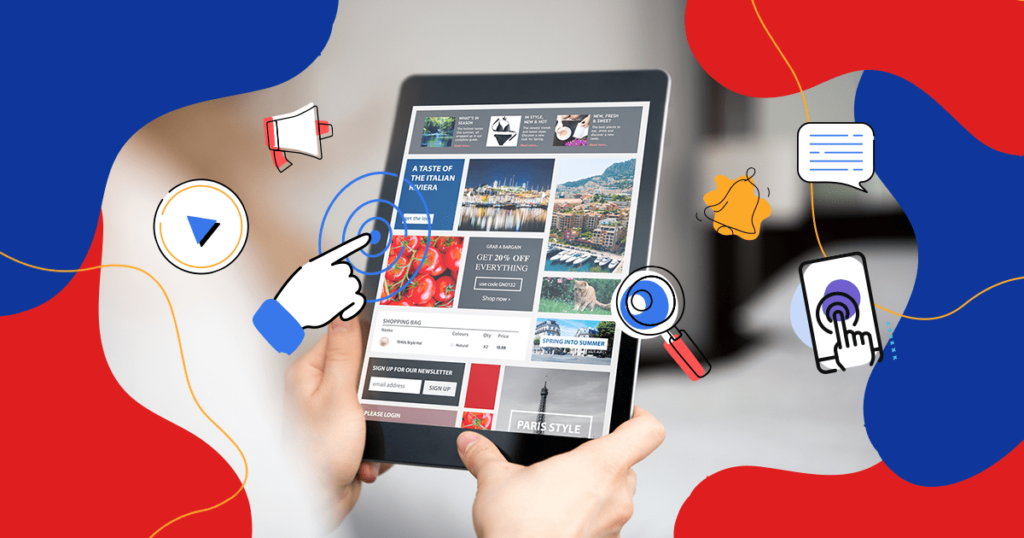We live in a 100% connected reality. The latest data about mobile usage have shown that people are spending more time using mobile devices than ever. The amount of usage may vary depending on age, location, and interests, but we can’t deny that we spend a considerable part of our time interacting with our gadgets.
If you are a marketer you probably know what this means. It’s not a coincidence that many professionals already prefer to run mobile-first campaigns and structure their strategies in this format. More than ever, you have plenty of new opportunities right in front of you – or in front of your audience.
Since people are closer to their smartphones, watches, or tablets, you can take advantage of this proximity to think of potential mobile marketing tactics that will keep your brand closer to the public, while providing a more personalized and timely experience.
Whether you are running a mobile app or not, the opportunities are there and it is a fact that keeping these channels on your radar will help you improve the performance of your campaigns.
Check out below the mobile marketing tactics that I think are the most important ones if you want to take the most out of your digital strategies!
What is Mobile Marketing?
Mobile marketing is a dynamic online marketing strategy that leverages mobile devices to engage with a targeted audience.
Research shows that 67,95% of the mondial population has a mobile device. These gadgets became the key to communication with all kinds of people. Through them, your brand may connect with consumers 24 hours per day, wherever they are.
With over 5 billion mobile device users worldwide, these gadgets have become indispensable tools for communication. Ignoring mobile marketing in your digital strategy is a critical oversight in today’s digital landscape.
By using Mobile Marketing, your customers can, quite literally, carry your brand in their pockets.

What is Mobile-First Communication?
Many marketing strategies begin on a desktop.
This makes sense if you think about how we work in an office setting: on a computer.
Most of the time websites, emails, landing pages, and other marketing assets are designed for a desktop experience and then shrunk down to fit a mobile screen.
Mobile-first communication spins this on its head.
Rather than beginning big and shrinking it down, digital technology begins small and then scales up.
This means that instead of trying to make large designs fit into a small space, you begin with the more complicated mobile approach and then optimize those designs and strategies for the desktop as needed.
While mobile-first is usually used in the case of design, it also plays into marketing strategies.
Rather than designing and creating interactive marketing assets for a larger screen, and then trying to shrink it down to fit into a mobile device, you can begin with mobile in mind and assume that most of your users are on mobile devices when interacting with your brand.
The Impact of Mobile Marketing
It’s important to know the benefits of using Mobile Marketing in your digital strategy. Below, we’ll explain the most important ones.
1. Broad Reach and Instant Connection
Over 67.95% of the global population owns a mobile device, providing a vast audience reachable 24/7. Utilizing mobile marketing allows your brand to connect with consumers instantly through channels such as SMS or push notifications.
2. Precise Audience Segmentation
Mobile devices offer the ability to pinpoint your audience’s location, enabling personalized campaigns and incentives. By integrating with GPS apps like Waze or Google Maps, businesses can offer targeted discounts to users in specific geographic areas.
3. Sales Growth in Mobile Channels
Mobile commerce is on the rise, with 82% of US internet users shopping on mobile devices. Mobile buyers also tend to spend twice as much as other consumers, indicating significant growth opportunities in this channel.
4. Impulsive Buying
The accessibility of products on mobile devices contributes to impulsive buying behavior. When your brand is readily available on a consumer’s phone, the decision to make a purchase becomes more immediate.
9 Most Common Mobile Marketing Strategies
1. App Marketing
We all know that developing an app from scratch requires a considerable budget.
Having a mobile app will give you more tools to approach your audience but it is important to understand if it is worth making such an investment or when to do it. Here are a few questions that can help you decide:
- Who is my target audience?
- Is my audience really a mobile app user?
- Is there any other app doing the same job?
- How useful is it going to be?
- How would my app help people have a better experience with my brand?
- What is the purpose of my app? Awareness? Education? Sales?
- What kind / how much return do I expect?
- Do I have the budget to invest in a high-quality app?
After answering questions like these, take some time to think about it and analyze the current scenario, then you will probably have a better idea about the feasibility of developing an app or not. If you decide to go ahead with it, there are many opportunities to take advantage of. If you’re not going further with it, don’t worry, we still have lots of gaps that need to be filled!

2. Notifications
If you look at your phone’s notifications center right now, I am almost certain that there will be some banners waiting for you to click on, right? This is one of the main tactics that apps apply to show relevant information and offers to their users.
Before implementing it, it is important to know the two different types of notifications that we receive – or send:
Push notifications
These are probably the ones that make your phone beep many times a day. Push notifications are sent aiming to create an interest in a product or service offer. It can be a discount, promotion, news, or just with the objective of catching your attention and clicks. Some examples are a new movie on your streaming platform or a discount coupon on a delivery app.
Pull notifications
You will probably click on these ones. Pull notifications are those you receive when you have already interacted with an app and it gives you some feedback or update. Some examples are when your food has left the restaurant or when the car you have ordered has arrived.
For notifications strategies, you should be the most creative as possible and use all the features a mobile app allows to send more personalized communication, making it more likely to capture clicks and lead your users to complete the task you aim for.
3. Messaging as a marketing tool: SMS + Whatsapp
Well, we know that people are much more connected to their phones. When it comes to messaging apps, this channel is also very important since people use it as a quick way to get in touch with their friends and family.
You probably get Messenger notifications many times a day and read them as soon as you have time. This can also be a good way to stay closer to your audience if you have their phone number.
We can consider messaging apps as a source of push notifications. This can be useful for small businesses that still don’t run an app and want to promote products, launches, seasonal offers, or discounts. Creating broadcast lists with a great copy leading to a link or even to convert through the chat, might help you gain good sales opportunities.
The same strategy can be applied to SMS. The difference here is that this type of message may have a cost. A platform to send multiple messages is needed just like the carrier itself, which may charge per message or a monthly/yearly plan.
SMS messages can stand out though, this channel is not commonly used for personal messages anymore. Another benefit is that there is no need to be connected to the internet, so just having a phone signal is enough to deliver the message.

4. SOLOMO: Right place at the right time
The term SOLOMO is a gathering of the initials: Social + Location + Mobile. It brings the possibilities to be explored by these three variables. Some of them are:
- Adding your business location on Google or Instagram;
- Invite people to check in on their social media. Some businesses use this tactic to provide free wifi connection after check-ins;
- Invite people to tag your business on social when they are at certain locations;
- Add a QR code sticker to ask visitors for a review on Google or Tripadvisor;
- Create beautiful environments for photos with your logo or any other branding icons. This can be a personalized table, plate, glass, or even scenarios for photos, so when people take a picture and post it, their network will see where it was;
The main goal here is to be creative and make your brand stand out while people experience your product or service. SOLOMO tactics can be cheap and simple but there is a high chance of getting good results with it.
5. Location Based Marketing (LBM)
You probably know or at least have heard about ABM – Account-Based Marketing. We have already talked about it in our blog and you can take a deeper look at it here. When it comes to LBM, however, the strategy is to work with personalization according to the location of a person/business.
A good example of it is when you are at the airport and you get a notification regarding your flight or when you receive an email about an event happening in your city.
There are many ways to take advantage of this, especially if your company runs an app. Having a person’s location means you are able to set specific types of communication, like sending an invite to visit a store when they are close to it, or map your competitors and send personalized communications when your clients are at one of your stores.
There are even cheaper ways to use this strategy. If you have a contacts base with phone codes, you can segment into regions and send different offers to specific locations. Another way of applying an LBM strategy is running a survey with your audience to know where they are and enrich your contact base with this information, creating new possibilities of segmentation and personalization.
It is extremely important to keep in mind that keeping an eye on your client’s location is very serious and might look a little scary, depending on how you use it. That’s why it is important to know exactly what GDPR states about this and all the regulations regarding the capture and use of personal data.
6. Advertising
There are plenty of ways to plan an advertising campaign in the digital environment.
The first thing you need to know is: which public am I aiming for? When creating a paid campaign, it is very important to know exactly who you are targeting. Create different types of segmentations and try to think as if you were the person who is looking for your product or service.
If you know that there is a good volume of people searching for your products or services on Google, launching a paid campaign with Google Ads might be interesting to start.
However, there are other possibilities, like running social media ads or working with programmatic advertising, so you will be able to automatically buy digital spaces for ads according to your preferences. This is a good way to work with specific segmentations in a wide variety of channels.
7. Social media
We have mentioned this channel a few times in this article but it is nice to have a specific topic for social media. There are a lot of opportunities here you should be thinking about, like paid initiatives and organic growth.
It doesn’t matter what your product, service, public, or strategy is, there are some tips that can help you get better results for your strategies in social media:
- Have a clear and branded profile. Communicate with your audience in a way that people will instantly know that they are seeing a post from you;
- Produce relevant content. Try to understand what kind of content your audience likes to consume and give them what they want;
- Post strategically. Think of the buyer’s journey and try to create different posts and offers according to each stage of the funnel;
- Be consistent and constant. People are using social media every day, so why not “say hi” to them every day?
- Exploit the most out of the platforms. You can use polls, quizzes, videos, trends, and all the possibilities the platform offers. This is a good way to get engagement and capture helpful feedback.
- Partner with digital influencers. These folks are professional speakers about products and help brands reach higher audiences in specific niches. They usually have a loyal and trustworthy public so it can be a good idea when making a launch or seasonal campaigns.
Once again, it is good to have in mind what social channels your audience uses the most. This way, you can focus on the stronger ones and think of entry strategies for others.
8. Wi-Fi Marketing
Offering free Wi-Fi and encouraging check-ins through social media apps can promote brand visibility. This strategy helps engage customers while providing a valuable service.
9. Mobile Games, QR Codes, and Barcodes:
Integration with mobile games, along with utilizing QR codes and barcodes, facilitates interaction between online and offline channels. These innovative approaches can lead customers seamlessly to the shopping cart.

Interactive Content Important for Mobile Marketing
Interactive content is an important aspect of a successful marketing strategy.
It provides many benefits that make it superior to traditional content and a worthwhile avenue to invest in.
Interactive content creates a better user experience than traditional content.
When content is interactive, it becomes a source of entertainment for your users and adds some fun to the content experience.
Rather than passively reading an article, your users can enter their own ideas, choose what to click or read next and think through options in order to tailor and personalize the content experience to their liking.
All of this interaction also helps to boost engagement. When a user is actively participating in their own content experience, they are more likely to convert to the next step in the buyer journey by clicking on a link or submitting their information.
Users are also more likely to support a brand that can deliver a great interactive experience.
Finally, interactive content helps to increase your lead generation efforts and improve your marketing workflows.
Interactive content has visual appeal and dynamic elements that encourage users to join in your sales and marketing funnels.
By making the experience of engaging with content more enjoyable, you can pull in more leads and find more ways to reach out to your audience.
Now let’s look at some specific interactive content ideas that you can use to boost your mobile strategy and create engaging experiences with your users.
Interactive Content #1: Mobile Strategy Games
Mobile strategy games are specific types of mobile apps and games that are geared towards thinking creatively and planning out decision-making to reach a specific outcome.
Mobile strategy games are some of the most popular types of games out there on mobile devices, and users are extremely dedicated to their favorite mobile strategy games.
By attaching your brand name to strategy games, you can increase engagement and brand recognition among mobile users.
Interactive Content #2: Gamification
Gamification is what it sounds like making things feel more like games.
It’s an interactive strategy that applies different elements of gaming, like scoring points or competing with others, to different areas of marketing.
It makes things much more fun for users and works great on mobile where your users are already geared toward clicking, playing games, and competing with others.
Interactive Content #3: Rewards Programs
Interactive rewards programs on mobile are a fantastic way to ensure that your customers keep coming back for more.
You can take the elements of gamification and use them within your mobile rewards programs to ensure that your customers get even more value out of purchasing from your brand.
You can make the action of spending points more fun and enjoyable for your readers to increase engagement and return sales.
Interactive Content #4: Microlearning
Microlearning is an interactive strategy where you help to educate and inform your audiences on mobile in an entertaining way.
Rather than just having them read an article, you can come up with short, informational videos, learning courses, infographics, games, challenges, and other content sources.
This allows your readers to learn within their attention spans and gather information at a pace that works for them.
How to Build a Mobile Marketing Strategy
1. Holistic Approach
Adopt a holistic approach that considers the entire customer journey. From awareness and consideration to conversion and retention, tailor your mobile marketing strategy to meet customers at every stage.
2. Personalization and User Experience
Personalizing your mobile marketing messages enhances user experience. Leverage data insights to deliver relevant content, product recommendations, and exclusive offers, creating a more personalized and enjoyable interaction.
3. Mobile-Friendly Content Creation
Crafting content specifically optimized for mobile consumption is paramount. Ensure that images, videos, and text are easily accessible and visually appealing on various screen sizes.
4. Data Analytics and Continuous Improvement
All of the tactics mentioned above may bring you insights to help you understand your results. It can be a reply rate on Messenger, number of downloads, clicks, ROI, and so on.
Whenever you plan a new strategy, think of how you are going to collect relevant data, metrics, and feedback from it. Develop a process to collect and analyze the data you collect. Thus, you will be able to set goals and have a better understanding of what needs to be done to achieve better results.
Running tests is also smart in order to get insights on potential improvements. You can try new channels, copies, designs, and so on. Once again, remember to measure your results, so you will really know what is working and what is not.
Another way to collect relevant information is by creating interactive experiences for your audience. You can build calculators, infographics, quizzes, and many other types of content while you naturally capture feedback from your audience, helping them engage with your brand and have a more personalized experience.
Want to know more about it? Get to know our Ion Interactive Platform.
5 for Optimizing Mobile Marketing Results
Building a Mobile Marketing plan is like any other marketing strategy. Some details can improve your results, so don’t forget to include the following elements in your plans.
1. Use a responsive site and content
One of the most important factors to reach success in a Mobile Marketing strategy is your website.
So, make sure the pages and the content follow the mobile Search Engine Optimization (SEO) best practices.
Google punishes the sites that don’t adapt to these devices, especially when the pages take a long time to load.
2. Use Google My Business
Google Maps is a tool that many of your consumers use on their mobile devices. So, consider registering your company on Google My Business.
Your brand will be more easily found both on mobile and desktop, especially by location.

3. Build a Mobile App
A big part of the customers (51% of them, according to Think With Google) use mobile apps to shop or search for products on their smartphones. That happens because they can get rewards or points.
Building a Mobile App may be worth the investment because, as we said before, it’s a competition-free environment.
4. Use SMS and push notification
Nowadays, we use our smartphones to text more than to make calls. So, it’s easier for the consumer to read a message.
In this context, push notifications and SMS are better than other types of approaches.
5. Create QR codes to incorporate in other channels
If you want to drive your audience directly to the shopping cart, use QR codes. Even if your touchpoint is offline, you’ll have a chance to close the sale without interference.
The codes work like a link directly to a specific page. Your consumers don’t need to type anything. All they have to do is point the smartphone camera to the QR code and get the content instantaneously.
You may create your codes on platforms like Kaywa.

Conclusion
Mobile Marketing strategies render a lot of good sales opportunities for companies. To improve your relationship with customers, let them be closer to your brand.
Using Mobile Marketing is not just a trend. It’s becoming mandatory. This way, you can keep your business up in the market and grow it.
Whatever mobile marketing tactic you want to apply, if only one or all of them, keep in mind your audience is always closer to their phones and spending more time with them. Try to be as empathic, timely, and personalized as possible.
Think of the possibilities relevant data might bring to you, but remember this can also be a sensitive point. So always have the GDPR guidelines in mind.
Now you know what Mobile Marketing strategies are and how to use them, it’s time to learn more about what Digital Marketing channels you may use. Check it out!







